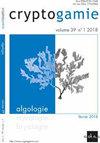A Study of the Morphology and Distribution of four Achnanthidium Kütz. Species (Bacillariophyta), Implications for Ecological Status Assessment, and Description of two New European Species
IF 1.5
4区 生物学
Q3 MARINE & FRESHWATER BIOLOGY
引用次数: 2
Abstract
ABSTRACT Six species of the genus Achnanthidium Kütz. with straight terminal raphe fissures including Achnanthidium caledonicum (Lange-Bert.) Lange-Bert., A. sieminskae Witkowski, Kulikowskiy & Riaux-Gob., Achnanthidium neomicrocephalum Lange-Bert. & F.Staab and Achnanthidium minutissimum (Kütz.) Czarn. were studied using light and scanning electron microscopy, and shape analysis. The type of Achnanthes microcephala f. scotica J.R.Carter (synonym: A. caledonica) and a population of A. neomicrocephalum from its type locality were investigated. Two new species, Achnanthidium tirolense sp. nov. and Achnanthidium lacuslustense sp. nov., found in two oligotrophic lakes in Germany and Austria, were described. Achnanthidium tirolense sp. nov. is distinguished by its rhombic-lanceolate valves with a slightly inflated valve centre and an acute-angled fascia on the raphe valve, and Achnanthidium lacuslustense sp. nov. by its large capitate poles, broad fascia on the raphe valve and strongly curved frustules. The distribution of A. caledonicum, A. sieminskae, A. neomicrocephalum and A. minutissimum in relation to land use and their species associations were investigated in 52 rivers, streams, and lakes of Scotland. Achnanthidium sieminskae, A. caledonicum, and A. neomicrocephalum were found in areas with low human impact where seminatural vegetation was dominant. The latter two species are typical in mountainous areas. In contrast, A. minutissimum sensu stricto was found in locations where human impact was greater. Although further data are required to determine which environmental variables underlie these distributions, our results suggest that the treatment of these species should be revised in ecological status assessments, and taxa aggregated under A. minutissimum sensu lato should be distinguished in ecological and biogeographical studies. RÉSUMÉ Étude de la morphologie et de la distribution de quatre espèces d'Achnanthidium Kütz. (Bacillariophyta), implications pour l'évaluation de l'état écologique, et description de deux espèces nouvelles européennes. Six espèces du genre Achnanthidium Kütz. à fissure terminale droite du raphé incluant Achnanthidium caledonicum (Lange-Bert.) Lange-Bert., A. sieminskae Witkowski, Kulikovskiy & Riaux-Gob., A. neomicrocephalum Lange-Bert. & F.Staab et A. minutissimum (Kütz.) Czarn. ont été étudiées en utilisant microscopie optique, microscopie électronique à balayage et analyse de forme. Le type d'Achnanthes microcephala f. scotica J.R.Carter (synonyme: A. caledonica) et une population d'A. neomicrocephalum provenant de sa localité type ont été étudiés. Deux espèces nouvelles, Achnanthidium tirolense sp. nov. et A. lacuslustense sp. nov., observées dans deux lacs oligotrophes en Allemagne et Autriche, ont été décrites. Achnanthidium tirolense sp. nov. se distingue des autres espèces du genre par ses valves rhombiques-lancéolées avec un centre valvaire légèrement gonflé et un fascia à angle aigu sur la valve du raphé, et Achnanthidium lacuslustense sp. nov. par ses grands pôles capités, un large fascia sur la valve du raphé et des frustules fortement incurvés. La distribution de A. caledonicum, A. sieminskae, A. neomicrocephalum et A. minutissimum en relation avec l'utilisation des terres et leurs associations d'espèces ont été étudiées dans 52 rivières, ruisseaux et lacs d'Écosse. Achnanthidium sieminskae, A. caledonicum et A. neomicrocephalum ont été recoltées dans des zones à faible impact humain où une végétation semi-naturelle dominait. Ces deux dernières espèces sont typiques des régions montagneuses. En revanche, A. minutissimum sensu stricto a été recoltée dans des endroits avec un impact humain plus important. Bien que des données supplémentaires soient nécessaires pour identifier les variables environnementales qui déterminent ces distributions, nos résultats suggèrent que l'identité taxonomique de ces espèces devrait être révisée dans les systèmes de bio-indication, et que les taxons groupés sous le nom d'A. minutissimum sensu lato devraient être séparés dans les études écologiques et biogéographiques.四种棘豆属植物形态与分布的研究。种(硅藻门)、生态状况评价的意义及两个欧洲新种的描述
摘要/ ABSTRACT摘要:本文分Achnanthidium k tz属6种。具有直的末端裂缝,包括Achnanthidium caledonicum (Lange-Bert.)Lange-Bert。, A. sieminskae Witkowski, Kulikowskiy & Riaux-Gob。,新小头棘球蚴。& F.Staab and Achnanthidium minutissimum (k z.)Czarn。用光镜和扫描电镜对其进行了研究,并进行了形状分析。对小头棘球蚴(Achnanthes microcephalala f. scotica J.R.Carter,同名:a . caledonica)和新小头棘球蚴(a . neomicofcephalum)在其类型地的种群进行了调查。报道了在德国和奥地利两个贫营养湖泊中发现的两个新种:Achnanthidium tirolense sp. 11和Achnanthidium lacuslustense sp. 11。其特征是其菱形披针形瓣,瓣中心略膨大,中缝瓣上有锐角的筋膜;其特征是其大的头状极,中缝瓣上有宽的筋膜和强烈弯曲的果壳。本文调查了苏格兰52条河流、溪流和湖泊中caledonicum、sieminskae、neommicroshophalum和minutissimum的分布与土地利用的关系及其物种关联。在人类活动影响较小、半自然植被为主的地区,发现了绢草、绢草和新小头草。后两种在山区是典型的。相反,在人类活动影响较大的地区,发现了最小感草。虽然需要进一步的数据来确定这些分布背后的环境变量,但我们的研究结果表明,在生态状况评估中应修订这些物种的处理方法,并且在生态和生物地理研究中应区分聚集在小黄犀下的分类群。RÉSUMÉ Étude形态学与分布学研究。(硅藻纲),对“1”的影响,“1”的“1”的“1”的“1”的“1”的“1”的“1”的“1”的“1”的“1”的“1”的“3”的描述。六种蜈蚣草。裂谷终端机裂谷(裂谷终端机裂谷)Lange-Bert。, A. sieminskae Witkowski, Kulikovskiy & Riaux-Gob。, A.新小头脑。& F.Staab等A. minutissimum (k兹。)Czarn。光学显微镜,电子显微镜,电子显微镜,混合和分析。小头蛇(a.s caledonica)等1个种群。新小头症的来源是一种地方性的 型的 型的。新个体,11月和11月A. lacuslustense, 11月,观察到在Allemagne和Autriche中有两个低营养个体的个体,而不是单纯的个体。Achnanthidium tirolense公司11月11日发布的文件显示,不同的数据显示,不同的数据显示,不同的数据显示,不同的数据显示,不同的数据显示,不同的数据显示,不同的数据显示,不同的数据显示,不同的数据显示,不同的数据显示,不同的数据显示,不同的数据显示,不同的数据显示,不同的数据显示,不同的数据显示,不同的数据显示,不同的数据显示,不同的数据显示,不同的数据显示,不同的数据显示,不同的数据显示,不同的数据显示,不同的数据显示,不同的数据显示,不同的数据显示,不同的数据显示,不同的数据显示,不同的数据显示,不同的数据显示,不同的数据显示,不同的数据显示,不同的数据显示,不同的数据显示,不同的数据显示,不同的数据显示,不同的数据显示。A.分布,A. caledonium, A. sieminskae, A. neomicmicrocephalum和A. minutissimum的关系,以及对土地和技术协会的利用,以及与 的 的 的 的的的的的的组织。单胞胞、单胞胞、单胞胞、单胞胞、单胞胞、单胞胞、单胞胞、单胞胞、单胞胞、单胞胞、单胞胞、单胞胞、单胞胞、单胞胞、单胞胞、单胞胞。两种不同的生活方式和生活方式都有不同的特点。在报复方面,a .最低限度的意义上严格地认为,在对人类的影响上,最重要的是,在对人类的影响上,最重要的是,在对人类的影响上。不确定的交换交换交换交换交换交换交换交换交换交换交换交换交换交换交换交换交换交换交换交换交换交换交换交换交换交换交换交换交换交换交换交换交换交换交换交换交换交换交换交换交换交换交换交换交换交换交换交换交换交换交换交换交换交换交换交换交换交换交换交换交换交换交换。最小感知延迟变异être ssamparacimans, les sametans, sametacologiques和biogmograpques。
本文章由计算机程序翻译,如有差异,请以英文原文为准。
求助全文
约1分钟内获得全文
求助全文
来源期刊

Cryptogamie Algologie
生物-海洋与淡水生物学
CiteScore
2.60
自引率
7.70%
发文量
11
审稿时长
>12 weeks
期刊介绍:
Cryptogamie is a fast-track and peer-reviewed journal of international scope publishing in English only. It accepts original papers and review articles on the taxonomy, biology and ecology of all cryptogams. An issue of Cryptogamie may be devoted to a single topic, under the responsibility of guest editor(s). All articles published in Cryptogamie are compliant with the different nomenclatural codes. A copyright assignment will be signed by the authors before publication.
Cryptogamie, Algologie accepts articles on systematics as well as ecology and evolution of any kind of algae (including Cyanobacteria).
 求助内容:
求助内容: 应助结果提醒方式:
应助结果提醒方式:


